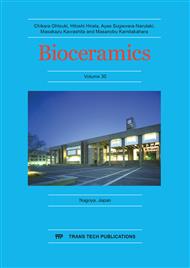p.212
p.218
p.227
p.233
p.238
p.244
p.250
p.256
p.262
Surface Characterization of Dental Porcelain Made from Sumatera Natural Sand
Abstract:
This research reported hardness and porosity morphology results on five different sintering temperatures as surface characterization of dental porcelain made from Sumateran natural sand mixture composition to prevent excessive wear. Porosity morphology was characterized with JEOL Scanning Electron Microscope (SEM), while the average hardness of each 5 different indented areas was performed with 1000 gr load for 15 seconds using Zwick Roell Vickers Hardness Tester. The result of this study shows that the higher sintering temperature correlates to higher hardness number. SEM analysis indicate less porosity appear in the samples sintered in higher temperature. By modifying the mixture, this study has significantly lowered the hardness number results compared to our previous research samples yielded 936,06 VHN. It can be concluded that positive correlation between higher temperature and hardness emerged from the surface characterization results of the dental porcelain made from Sumatera natural sand. In contrasts the porosity appear to be less developed in higher temperature. However, cracks and pores followed the indentation as in common ceramic products. Further improvement is needed with finding the optimum temperature of desired hardness number and predictable porosity, which resemble tooth enamel.
Info:
Periodical:
Pages:
238-243
Citation:
Online since:
October 2018
Price:
Сopyright:
© 2018 Trans Tech Publications Ltd. All Rights Reserved
Share:
Citation:


